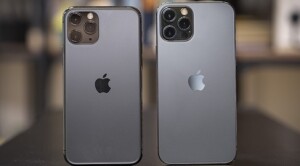iPhone 11 Pro vs iPhone 12 Pro: What should you buy?
Tuesday, January 26th, 2021If you’re looking to upgrade to Apple’s best recent iPhones, you’re probably looking at the recent iPhone Pros. Now the real question is, how do you decide between the iPhone 12 Pro and the iPhone 11 Pro? And is there actually a difference? Here’s a clear and easy breakdown to help you decide what phone is the best for you.
Price
Money makes the world go around. Getting a new iPhone is an investment so let’s break down what you’ll pay for each phone. The iPhone 12 Pro starts at £999 for 128GB of storage. Meanwhile, the iPhone 11 Pro started at £1,049 for 64 GB when it launched in 2019 but it can be picked up right here on Unlocked Mobiles for £999. Best bang for your buck? Buying on Unlocked Mobiles saves you money on both phones and offers Sim Freedom to maximize your savings!
Design
There wasn’t any huge visual design changes between these two models. The iPhone 12 Pro features a 6.1inch display in a fairly compact design that measures 146mm x 71.5mm x .29mm and weighs 189 grams. While the iPhone 11 Pro offers a 5.8inch display in a handset that measures 144mm x 71.4mm x .32mm and weighs in at 188 grams. The real difference lies in durability. Unlike the iPhone 11 Pro, the iPhone 12 Pro offers a Ceramic Shield front with 4x better drop performance. It is also has a deeper maximum depth in splash, water, and dust resistance. Care more about battery life? The iPhone 11 Pro has a slightly longer video playback life, while the audio playback life is identical in both phones. Our Vote? The iPhone 12 Pro is the clear design winner in measuring durability and resistance. You no longer need to be nervous about those beach days!
Display
The OLED displays on the iPhone 12 Pro (6.1inch ) and the iPhone 11 Pro (5.8inch) are stunning. We’re talking, your grandpa will think he’s looking out a window kind of stunning. The phone’s brightness, colour, and photo accuracy is the best you’ll find on any phone. The displays are identical across the board from colour quality, to brightness, to contrast ratio. The main difference is the iPhone 12 Pro has a slightly higher pixel resolution. No wrong choice here. The handsets are very similar but hit up the iPhone 12 Pro if you want the most modern and innovative image.
Camera
But what if your amateur Instagram photography business is taking off and you need to come through with quality pictures? It’s no secret that Apple has been killing it with their phone cameras. Both the iPhone 12 Pro and the iPhone 11 Pro have a triple 12MP camera system with Ultra Wide, Wide, and Telephoto lenses. Not to mention, both phones record Dolby Vision video in 4K for stunningly colorful footage. What about photography at night? If you’re looking to shoot in the dark, the iPhone 12 Pro is the one for you. The Wide Camera has an f/1.6 aperture. This allows 27% more light than the iPhone 11 Pro for better low light photos and videos. The iPhone 12 Pro also introduces Night Mode Portraits to maximize night mode quality. Both phones will capture masterpieces but if you’re looking to the capture adventures under the night sky, you have to go with the iPhone 12 Pro.
Summary
So there you have it! There’s no wrong choice. The iPhone 12 Pro and the iPhone 11 Pro are both sleek, high-speed devices that excel industry-wide in display quality, performance and photography. If you want my two cents, I’d go with the iPhone 12 Pro for the best durability, photography, and the most powerful chip in a smartphone. You can get both phones on Unlocked Mobiles today for sim freedom, and fast delivery!





